

Site Search
Search within product
第759号 2024 (R06) .04発行
Click here for PDF version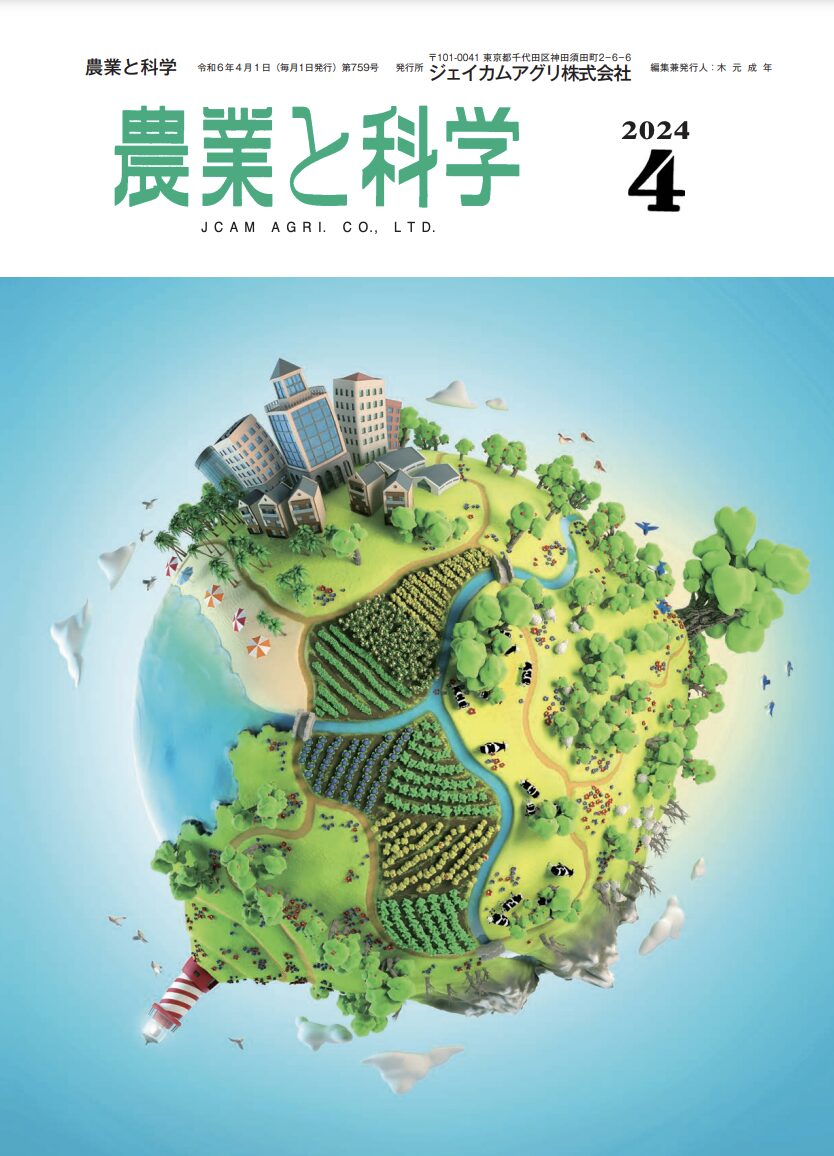
農業と科学 令和6年4月
本号の内容
§園芸作物の光応答反応と農業技術(1)
-キクとイチゴにおける電照の現状-
Former Graduate School of Natural Science and Technology, Okayama University
桝田 正治
§土のはなし-第30回
農業と環境問題-その5
農業由来の温室効果ガスと地球温暖化
前 ジェイカムアグリ株式会社
北海道支店 技術顧問
松中 照夫
園芸作物の光応答反応と農業技術(1)
-キクとイチゴにおける電照の現状-
Former Graduate School of Natural Science and Technology, Okayama University
桝田 正治
Introduction.
The author has been working on the previous two reports.1)In the previous section, we discussed nutrient absorption and translocation in tomato during the day and night, and since plants generally assimilate carbon dioxide during the day, much of the research has focused on the light-response response during the day. Light intensity strongly influences dry matter production, and the light saturation point (the point beyond which light intensity does not increase the rate of photosynthesis) of major horticultural crops is well established. The light saturation point of potatoes, eggplants, tomatoes, and watermelons grown from spring to summer has a high light saturation point of 50,000 to 80,000 lux, while that of carrots, radishes, Chinese cabbage, spinach, and other so-called autumn vegetables grown from fall to winter is low and falls in the 30,000 to 50,000 lux range. Incidentally, the maximum irradiance on sunny summer days is close to 100,000 lux. Of course, since temperature affects the rate of photosynthesis, the above-mentioned light saturation point is based on the optimum temperature for growth.
On the other hand, Garner and Allard of the U.S. reported in 1920 that the length of light (daylight), rather than the intensity of light, affected flowering of plants. This was about 100 years ago, and it was shown that certain varieties of tobacco and soybean would only flower when daylight length was shortened. This discovery marked the beginning of modern research on flowering, and its influence quickly swept the world of botany and agronomy.2)describes the European text of the experimental situation at that time as follows
「1917年7月10日午後4時にアラードが栄養成長を続けているメリーランドマンモス種のタバコ3鉢とペキン種のダイズを自分で考案し冗談半分に犬小屋と呼んでいた暗箱に入れたところから始まっているが,この実験は昼休みの間に仲間とおしゃべりをしている間に思いついたと言われている」と。アメリカ,ワシントン州の緯度では,昼が十分短くなる前に寒さが到来するので,タバコは花の咲く前に枯れていたのである。この発見が,短日植物,長日植物と言った用語を生み,その後,植物の光周性として広く認知されるようになった。
光周性の農業分野への応用の最たるものは電照ギクである。キクの日長制御,その技術の歴史は直近の白山の総説3)This light control technology also plays a major role in the promotion of strawberry cultivation, as described in detail in the following section. Although the purpose of irradiation is different between strawberry and chrysanthemum, they both have in common the control of growth (strictly speaking, growth in strawberry and development in chrysanthemum).
In this paper (1), the response to the length of day is discussed focusing on these two horticultural crops, and in the next paper (2), the theoretical background of irradiation is mainly discussed. The next paper (2) will mainly discuss the theoretical background of irrigation in strawberries, based on interviews with experimental stations in various prefectures, as well as on published articles, my own experience, and the papers of others.
1. Is day (light) - night (dark) necessary for plants?
Plants have developed a purposeful mechanism for survival within the daily day-night cycle. The necessity of daytime for survival is self-evident in terms of obtaining the energy source for life, but what about nighttime? If a human being does not sleep for three days, he or she will go insane, and the record for the longest experimental period of life is 11 days. Sleeping is an action of meditating and does not necessarily mean nighttime. On the other hand, in the case of plants, there is no movement, so we must use the word "night (darkness)" as the corresponding term. Of course, both plants and animals live in a light-dark cycle and have developed circadian rhythms through a long evolutionary process.
Whether night (darkness) is necessary for plants can be determined simply by examining the length of day (light). The maximum length is 24 hours of illumination (continuous light). Lettuce has long been known to tolerate long hours of illumination, with plant factories providing up to 20 hours of illumination (4 hours of darkness).
The author has measured the light intensity of 200 µmol-m for eggplant crops.2... s-1≒When examined under ≈18,000 lux fluorescent lighting, at least 4 hours of night were required for tomatoes and 6 hours for eggplant. Eggplants, in particular, looked horrific without night, with gouged leaves unfolding under the light.4)(Figure 1). However, bell peppers can produce stable fruit set and vigorous growth and enlargement even without a night5)Therefore, we investigated eight Korean pepper cultivars and found that all of them grew well under continuous light. The inter-varietal differences in the expression aspect of the eggplant and cucurbit families, as well as the physiological changes in the plants associated with the expression of the disorder, are reviewed in Hata et al.6,7)The following is an exhaustive detailed description in the
The tolerance response of the crop to continuous light varies with light intensity and carbon dioxide concentration, but even continuous-light tolerant peppers develop thicker leaves as they age, and yellowing symptoms begin to appear on the leaves after six months of age. However, as long as the branches are trimmed back, the plant will continue to produce fruit without problems (Figure 2). Many plants have difficulty surviving without nighttime sunlight, but how do lettuce and other pepper crops develop tolerance? From the viewpoint of plant factory production, this is an issue that remains to be investigated.
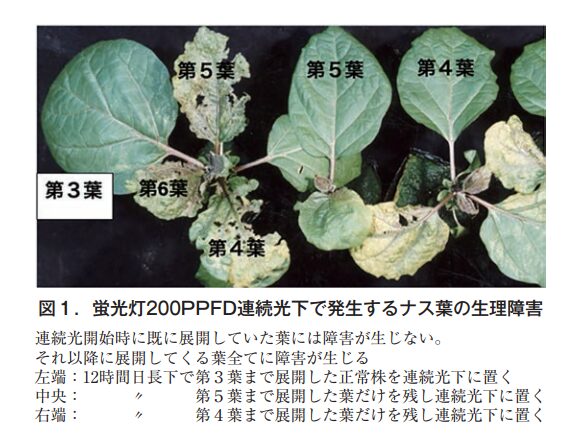
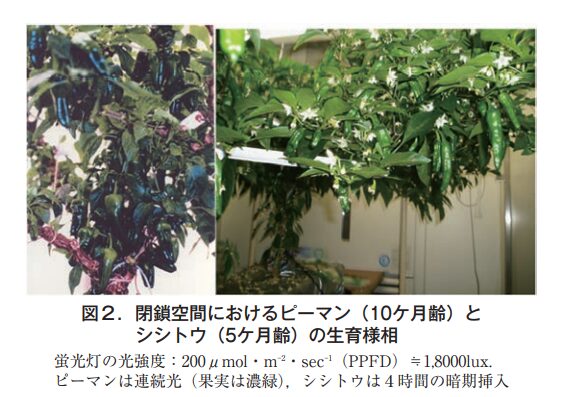
2. softening cultivation by dark treatment
Softening here refers to the technique of not turning green. Examples include chikon (soft white chicory), asparagus, udo (Japanese udo), and chives. The key to all of these is the cultivation of the rootstock. With the exception of chicory, it takes 2 to 3 years to obtain a full rootstock from seed, whereas it takes almost a year to soften the rootstock if it is divided.
Chicory is grown in Nagano and Hokkaido because it prefers cooler climates, and there was a time when its bitterness was said to match that of grilled meat. This was about a quarter of a century ago. Sasaki8)The "Chikon" section points out the situation and problems of chikon production in Japan at that time. In France and Belgium, chikon is known as an indispensable vegetable for the daily table. Figure 3 is a picture of chicon harvest taken by the author in Belgium. The training plants resemble carrots. It is stored in ice for a long period of time and sprouts at around 15 to 17℃ on the anniversary of its harvest. I do not know if the Westernization of the world will lead to a time when people will prefer this kind of food, but it seems to be a vegetable with a unique bitter taste different from that of lettuce.
Asparagus and udo, on the other hand, should not be dug up, but instead should be placed at the base of the plant to block out light by covering the plant with soil, fill, or shells. Digging up the rootstock and moving it to a dark room will soften the entire plant.
When the chives are cut at the edge of the ground with blue leaves and the plants are covered with a black plastic tunnel, the leaves that develop in the dark have almost no chlorophyll and are yellow (xanthophyll), which is the yellow chive. If the plant is cut and left in the shade, it will green up in no time at all. Since the commercial value of greenish yellow chives is significantly reduced, the Agricultural Research Institute of Okayama Prefectural Agriculture, Forestry and Fisheries Research Center has long been working on the development of technology to prevent greening of yellow chives.9). Leaves of chives grown in the dark have little chlorophyll and a strong yellow color, and if the leaves are exposed to sunlight (high light), the green color is suppressed even if they are subsequently exposed to weak light. This is the sun-drying shown in Figure 4.
Okayama Prefecture currently ranks first in Japan in the production of yellow chives, accounting for approximately 70% of all chives grown in the prefecture. At the Yanahara Mine (a pit left over from iron sulfide mining), geothermal heat is used to produce yellow chives (Horikami stock) even now in midwinter. In my vegetable garden, I cut a 20-cm-diameter vinyl chloride pipe into 50-cm lengths, darken it, and expose it to strong light when harvesting. The tubes are moved to the next stump to obtain yellow chives intermittently.
On the other hand, if sun vegetables are pulled out and exposed to sunlight for half a day, the white roots will turn red after one day (Figure 5). The color of pickles can be changed depending on the exposure to light. The fact that this pigment (anthocyanin) is produced in the vicinity of damage even in the soil indicates that it has a mechanism that does not necessarily require light for the production of the pigment.

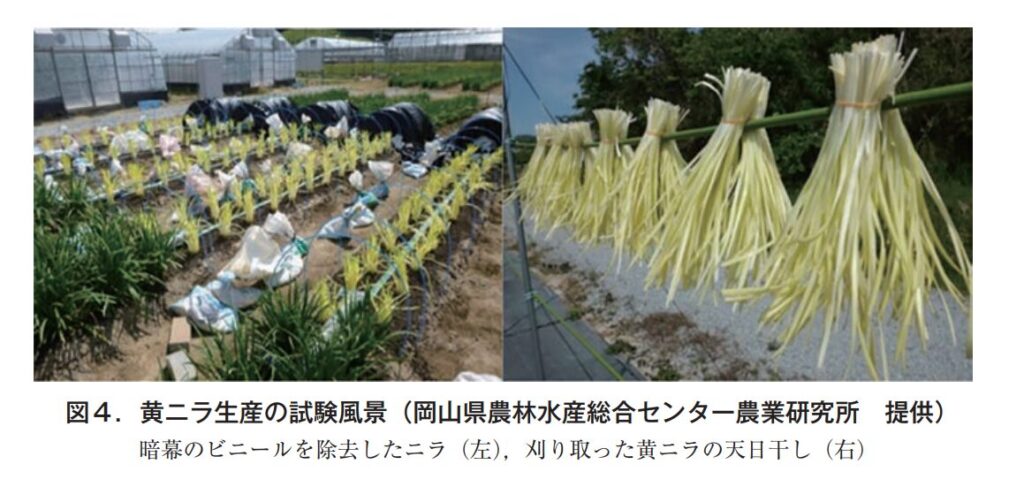
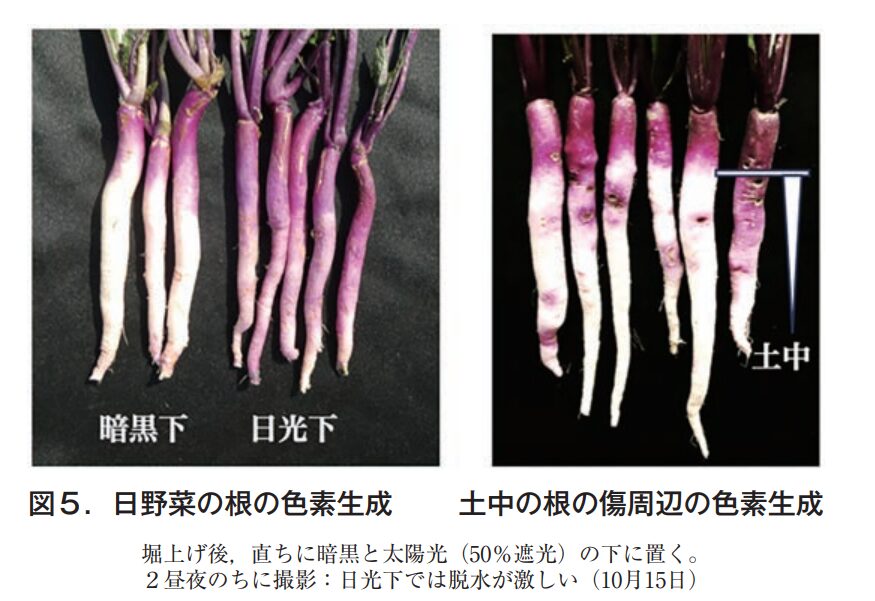
3. production technology through day (day length) or night (dark period) manipulation
Japan is located at mid-latitude and produces four distinct seasons, while the length of days and nights do not change throughout the year at the equator. The author was involved in the establishment of Jomo Kenyatta University in Kenya for 10 years, and went to Nairobi almost every year to prepare the syllabus for the Department of Horticulture and to supervise education and research. The sun rises at 6:00 am and sets at 6:00 pm. Day and night always switch in this cycle. Poinsettias, which decorate Japanese storefronts at Christmas time, grow into large trees in Kenya, and each branch is either red or green. When I saw this, I realized that the critical daylength of poinsettia, which is considered a short-day plant, is around 12 hours, and that each branch has a slightly different daylength sensitivity. It is normal for the light response to change as the branch ages, as the young leave the parent, and as the branch is inserted into a sapling. In addition, these responses often differ depending on the parental antecedents.
Although the methods of seedling production, seedling growth, and fertilizer management also affect the production of the following crops, I will focus here on the light-responsive response, which can be shared as a production technique, and describe the current state of the technology used in their operation. Night break is also called lightbreak, but the former refers to the dark period and the latter to the light.
(1) Illuminated cultivation of Aster
Aster is a short-day plant that blooms in autumn in countries located in the middle and high latitudes of the earth. After the summer solstice, the days gradually become shorter and the temperature gradually decreases in September. In response to this short day and cool temperature, Aster starts flower bud differentiation and development. Therefore, in order to have flowering earlier than in the fall, it is necessary to use black cloth in the spring for short-day treatment. This is so-called shade cultivation.
On the other hand, long-day treatment with electric light is necessary to delay the flowering time. Of course, the temperature at the time of treatment also has a strong influence, but these two basic operations establish a year-round production system for Aster, and in the case of summer-autumn Aster, lighting with an incandescent lamp at 50 lx for 4 hours or more is required.
However, about 30 years ago, I heard from a farmer in Okinawa that he was very anxious about light treatment in the middle of the night (meaning while he was sleeping) because it was difficult to check whether the light was actually on or not. It is well known that if the light is not turned on for 4 or 5 days due to a switch failure, the growth of the plant will become abnormal. If the switch fails for a prolonged period, so-called "willow buds" appear. Willow buds are so named because the flower buds that are just starting to form turn into trophic buds, which resemble willow leaves. In general, irradiation time is prolonged to about 4 hours to prevent growth anomalies.
However, with the recent development of light-emitting semiconductor LEDs (Light Emitting Diode), which have higher light intensity and lower power consumption, as well as more precise equipment, they have become popular as an alternative light source to incandescent and fluorescent lamps, and many studies have been conducted to find cost-effective methods of illumination and lighting time. Since the invention of the blue diode, white LEDs (blue + green + red) or blue + yellow phosphors have been widely used for plant production.
Toyohashi City is considered the birthplace of the Denshogiku, and with Tahara City and other locations on the Atsumi Peninsula, Aichi Prefecture boasts the largest annual production in Japan. Half of the chrysanthemums are illuminated by LEDs for four hours from 10:00 p.m. to 2:00 a.m., from mid-September to December. The flowering date is determined by the timing of the end of illumination. Until early November, when the greenhouses are covered with double layers of vinyl to keep the greenhouses warm, the lights of the greenhouses are reflected in a kamaboko-shaped pattern. On the other hand, in Okinawa Prefecture, where heating costs can be reduced during the winter, the flowers are grown in each village from January to March, later than in Aichi Prefecture, and are known as the "flower of the sun" in Okinawa. Unlike the greenhouse cultivation in Aichi Prefecture, Okinawa Prefecture cultivates the flowers in the open air, and LED lighting is provided for five hours from 23:00 to 4:00. The fantastic sight is said to be popular as a tourist attraction (Figure 6).
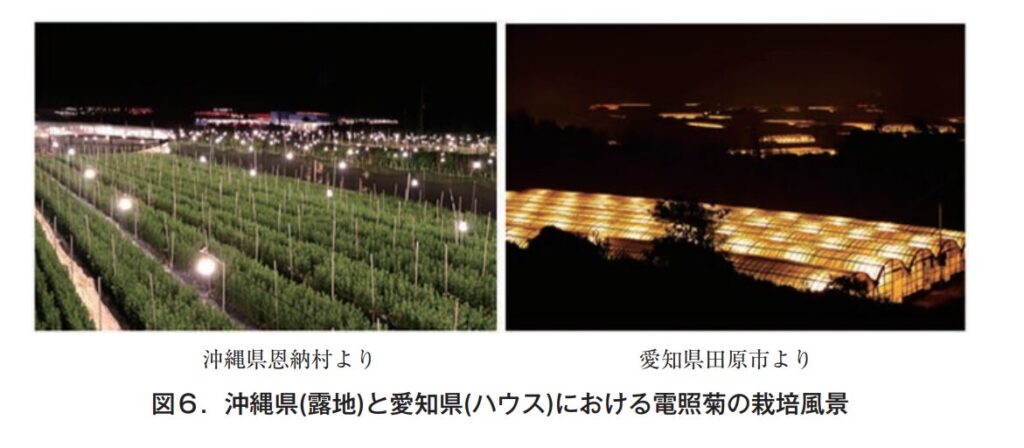
According to the 2021 Fukushima manual on cultivation techniques for summer and autumn daisies, red LEDs are the most effective and the irradiation time is 5 hours from 23:00 to 4:00. If irradiation is applied from the bud stage and the lights are turned off on June 15, flowering will occur 50 days later. However, the number of days to flower depends on the variety, region, and cropping pattern, so it is advisable to check the number of days to flower for the variety you want to grow in your field on a small scale.10)The following is a detailed description of the cultivation procedures for the August and September shipment types of small, spray, and rotary types. This is a very useful reference for growers, as it describes in detail the cultivation procedures for the August and September shipment types of small, spray, and rotunda.
MURASAKI and SUZUKI, Ibaraki Prefectural Agricultural Research Center, on lighting hours.11)は,8月盆出荷型小菊の花芽分化抑制効果が慣行(22~2時)の時間帯よりも午前0時~4時頃で高いことを明らかにし,この効果を現地試験において実証している。
alpine flanked by pines3)The peak wavelength of the industrial red light LED lamps used is not at the so-called 660 nm but at the reaction maximum of 630 nm for seed germination, and when the irradiation time is relatively long (4 to 5 hours), red plus far-red is as effective as red or more effective than red. When the irradiation time is relatively long (4 to 5 hours), red and far-red LEDs are as effective as or more effective than red LEDs. Currently, commercially available red LEDs have wavelength peaks at 630, 640, 660, and 670 nm, depending on the product, so the wavelength distribution of the lamp must also be taken into consideration when using them. On the other hand, far-red LEDs are located between 660 and 780 nm, with peaks at 700 and 736 nm.
In addition, he3)studied the time period of dark period interruption in Aster, and found that the time from the start of the dark period to the maximum effect does not change even if the length of the dark period (night) is changed, and that the maximum effect exists at the limit of the dark period required for flower development, not at the center of the dark period, and that to obtain an efficient inhibitory effect on flower development, it is important to move the time period to the limit of the dark period rather than increasing the irradiation time as the (night) becomes longer. In order to obtain an efficient inhibitory effect on flower growth, it is important to move the irradiation time to the limit of the dark period, rather than lengthening the irradiation time as (night) lengthens. In other words, it is important to link the time period to the maximum effect of dark interruption after a certain time after the start of the dark period in order to suppress flower bud differentiation, a typical example of which is shown in two Aster varieties (Figure 7).
If the critical daylength of autumn daphne 'Jimma' is approximately 14 hours (meaning that flower bud differentiation starts when daylength is less than 14 hours), the critical dark period length is 24-14=10 hours, and if night begins at 6:00 pm, the maximum effect of dark period interruption is 18:00 + 10 hours, which is around 4:00 am. If night begins at 6:00 p.m., the maximum effect of dark period interruption would be around 4:00 a.m. (18:00 + 10 hours). In the case of Natsuatsu-autumn (Asteraceae), the critical daylength is approximately 16 hours, and the critical dark period length is 8 hours, so if night begins at 6:00 p.m., the maximum effect is 18:00 + 8 hours, or 2:00 a.m. Since the time of sunset changes with the season, the maximum effect also changes accordingly. The seasonal variation in the time of day is more pronounced at higher latitudes, so it is necessary to pay attention to the seasonal variation in the time of maximum light interruption in production areas at mid-latitudes and above. In low-latitude production areas, such as tropical highlands, the time of maximum dark interruption is almost unchanged at 1:00 pm (Figure 8). This is a novel concept that incorporates the maximum effect of the dark interruption affected by the body clock into the established theory that flower bud differentiation in short-day plants, such as Aster, is initiated by a long night. We hope that this technology will be further developed as an actual technique, taking into account the cost-effectiveness of irradiation in addition to the physiological and ecological characteristics of Aster.
なお,限界日長(critical daylength)は古くから学術用語として定着している。昼の長さよりも夜の長さが重要であるからといって,限界暗期(長)と称するには安易に過ぎると筆者は長らく思ってきた。日常に目にする生育反応,24時間のリズムを前提にして夜の意味を理解するには限界暗期とするよりも「リズムの振れ」と「応答のゆらぎ」を夜に認めて臨界暗期(marginal dark-length)とした方がベターだと考えている,この紙面を借りて用語の提案をしておきたい。


(2) Illuminated cultivation of strawberries
How many people can answer the question, "When do strawberries turn color? As the saying goes, "The first fruits come in 75 days," it is desirable to grow strawberries as early as possible to live a long life, and about 50 years ago, the harvest season of strawberries was already advanced about six months by electric lighting. This is the so-called greenhouse promotion cultivation of strawberries.
Unlike the case of Aster, the purpose of irrigation of strawberry is to suppress the dwarfing of the entire plant (i.e., the phenomenon in which the petiole becomes shorter and the leaves smaller). In Japan, electric irrigation has spread nationwide, mainly due to research conducted in Nara Prefecture, and breeding has contributed greatly to the expansion of this cultivation. Table 1 summarizes the current status of strawberry irrigation based on the author's inquiries to each prefecture as well as many data. First of all, it can be commonly said that the irradiation period is generally from November to March, and the irradiation time is 3 to 4 hours, except for strawberries in Iwate Prefecture. The following is a brief description of the characteristics of the cultivation.
First of all, strawberries in Iwate Prefecture are exceptionally four-seasonal varieties, which have different ecological characteristics from strawberries in other prefectures. It is called "summer-autumn strawberry" and requires long-day conditions for flower bud differentiation. According to our interviews, all-night irradiation (continuous light) is applied at 2-week intervals during the growing season to promote flower bud differentiation and to secure the number of flower clusters. The data also indicated that 16 hours of daylength treatment is sufficient.
In contrast, all strawberry varieties in the other provinces are one-season cultivars, which usually begin flower budding in autumn and winter, and gradually dwarf at the same time. The low temperatures in winter cause the dwarfing to be resolved and the plants grow vigorously in the spring. In other words, they are spring-fruiting varieties that flower in spring and are harvested in nature. The current cultivation method is based on promoting cultivation by flowering in the fall and harvesting in the winter and spring. In this cultivation method, the first point is the management technique of runner collection and potting seedlings, and the second point is the subsequent management of grass vigor after planting. Here, the current status of electric irradiation for the latter grass management is described.
Table 1 shows that in all prefectures, electric lighting begins in mid-November or later. In other words, the electric irradiation starts more than one month before the winter solstice (astronomically December 21 or 22), when the night is the longest, to make the day longer and the night shorter (or to cut the night into two halves). After the summer, the days become shorter as the temperature drops, and this is when the strawberry begins to differentiate into flower buds. The basic characteristics of flower bud differentiation in strawberry were described in Ito's paper in 196312)This is the theory of strawberry promotion with respect to flower bud differentiation (Fig. 9).
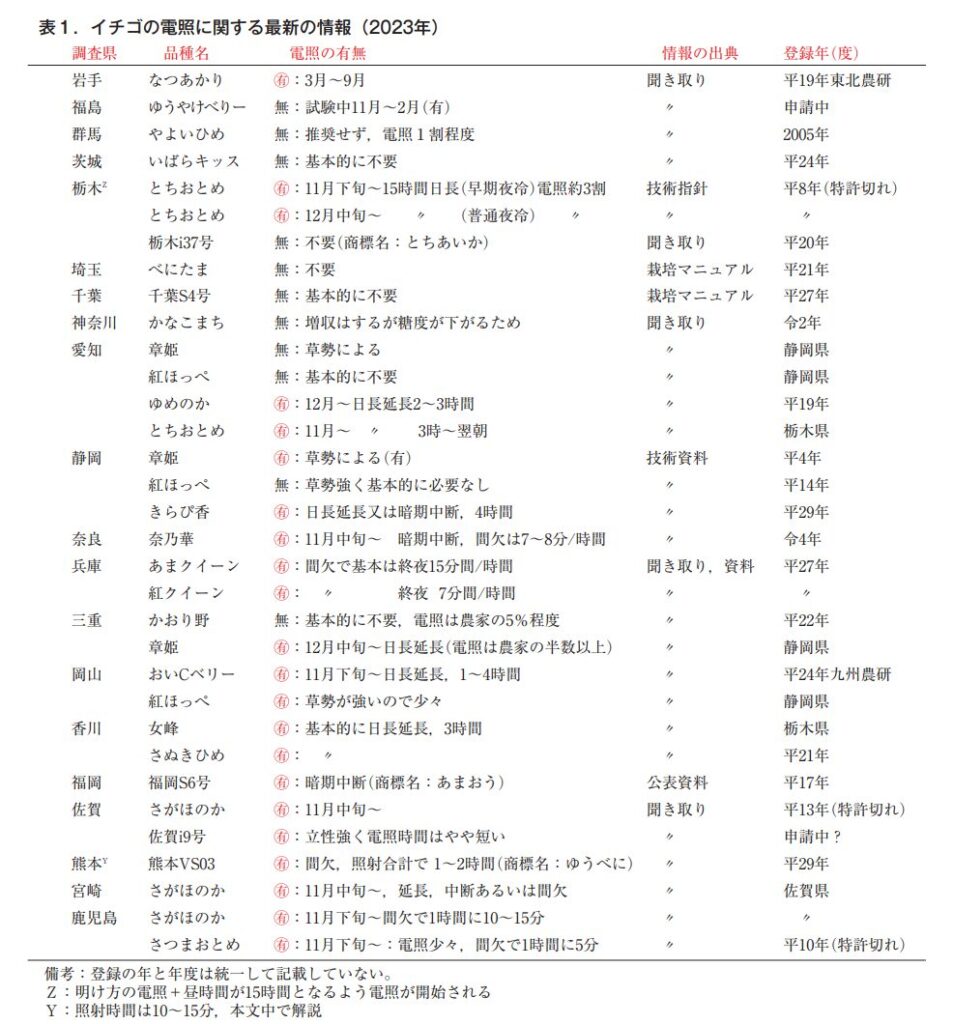

The basis of strawberry flower bud differentiation is that flower buds differentiate regardless of day length when encountering low temperatures (14°C or lower), but not when encountering high temperatures (27°C or higher), regardless of day length. In the medium temperature range (17-24°C), flower bud differentiation occurs when daylength is 14 hours or less, but not when daylength is higher than 24°C. This indicates that temperature is the main factor in flower bud differentiation. No matter how much the current cultivars are improved, the characteristics of flower bud differentiation can be explained by making slight modifications to this figure.
Although electric irradiation is started in mid-November in every prefecture, this irradiation should have a negative effect on flower bud differentiation. The reason for irradiation is that unlike the case of Aster, strawberry flower bud differentiation is led by low temperatures, so irradiation is meaningful to the extent that it does not have a negative effect on flower bud differentiation. This irradiation is exactly the operation to suppress dwarfing. This is a technique to prevent dwarfing, since the irradiation has little effect at the stage where dwarfing has already occurred. In the case of Kanagawa Prefecture's Kana-Komachi variety, irradiation increases yield but decreases sugar content, so irradiation is not recommended. It is thought that irradiation may cause excessive vigorous growth, resulting in a decrease in commercial quality. Because the intensity of dwarfing depends on the variety and the autumn climate, the presence or absence of irradiation, as well as the time and method of irradiation, are still under investigation.
From this interview survey, it was found that electric lighting is more frequent in the southern prefectures than in the northern prefectures, and the overall rate of electric lighting is estimated to be more than 70%, of which about 40% is due to daylong extension, about 40% to interruption of the dark period, and about 20% to intermittent lighting based on all-night hours. Intermittent illumination seems to be widely used in Kiku cultivation in foreign countries, but it is not common in Japan. The new strawberry variety 'Nanoha' from Nara Prefecture is illuminated either intermittently or intermittently during the dark period, with intermittent illumination lasting 7 to 8 minutes per hour.13)The intermittency in Hyogo Prefecture is quite detailed, as shown in Table 2. Intermittent irradiation in Hyogo Prefecture is quite detailed, as shown in Table 2, and the basic "6 p.m. to 6 a.m." period is 15 minutes per hour, for a total of three hours per night, which means that three to four areas of rotational irradiation can be set up.(14)He said that if the light intensity is insufficient or unevenly distributed, flowering and vigor will vary greatly. At this time, if light intensity is insufficient or unevenly distributed, flowering and vigor will vary greatly. In addition, the Kumamoto variety 'Yubeni' is irradiated systematically in 12 or less 10 to 15 minute durations during the night with the total irradiation time set at 1 or 2 hours. This irradiation method can be described as a "dialogue between strawberries and humans" with emphasis on the human eye, an extremely novel concept that is expected to develop into a pest management technique.
Needless to say, agriculture is endlessly challenging itself in all areas under the SDGs (Sustainable Development Goals) for food. How will Table 1 change in 10 years?
Acknowledgments: We would like to express our deepest gratitude to all the officials in the various prefectures who responded to our inquiries about strawberry irradiation.

References
1.桝田正治.2022.トマトの昼夜間における養水分吸収とその移行.
農業と科学741(6):1-8.
2. KANE, Y. 1979. developmental physiology of crops. Chapter 4. Chapter 4. control of flowering. p178.
3.白山竜次.2022.キクの電照栽培の再考察.
園芸学研究21:255-267.
4.Murage, E. N., Watashiro, N. and Masuda, M.1996.
Leaf chlorosis and carbon metabolism of eggplant in response to continuous light and carbon dioxide. Sci. Hort. 67:27-37.
5.Masuda, M, and E.N. Murage. 1998.
Continuous fluorescent illumination enhances growth
and fruiting of pepper. J. Japan. Soc. Hort. Sci. 67:862-865.
6.畑 直樹・桝田正治・村上賢治・小林昭雄.2011.
閉鎖型植物工場における連続光の利用(第1報)
連続光下におけるナス科・ウリ科作物の生育様相並びに障害発生.
植物環境工学23:93-100.
7.畑 直樹・桝田正治・村上賢治・小林昭雄.2012.
閉鎖型植物工場における連続光の利用(第4報)
連続光下における植物の生理学的変化ならびに障害誘発の概念.
岡山大農学報,101:49-64.
8.佐々木久視.1990.チコリーの栽培と軟白について.
北海道教育大紀要(II B),40:53-62.
9.岡 修一.2015.ニラの軟白栽培における露光処理が葉色に及ぼす影響.
岡山県農業研報.6:25-29.
10.福島県農業総合センター.2021.
計画的な生産・出荷のための夏秋ギク栽培技術マニュアル.
11.村﨑 聡・鈴木一典.2019.露地夏秋小ギクにおける電照時間帯が開花に及ぼす影響.
園芸学研究18:431-437.
12.伊東秀夫.1963.苺の花芽分化促進と温度及び日長の関係.
農業及び園芸34:829-830.
13.Nara Prefectural Agricultural Research and Development Center. 2021. cultivation technology guideline of strawberry variety "Nanohana".
14.兵庫県農林水産技術総合センター.2015.
イチゴ「兵庫I-3号」「兵庫I-4号」栽培マニュアル.
No Soil - 30th
農業と環境問題-その5
農業由来の温室効果ガスと地球温暖化
前 ジェイカムアグリ株式会社
北海道支店 技術顧問
松中 照夫
Previously, we have discussed the negative effects of nitrogen from agricultural land on the environment in four articles. In particular, we have discussed that air pollution caused by nitrogen from agricultural land is related to the emission of dinitrogen monoxide, a greenhouse gas, and contributes to global warming. In this article, we will consider the relationship between global warming and agriculture, including other greenhouse gases.
1. greenhouse gases and their merits and demerits
Life on the earth is probably due in large part to the existence of water and to the fact that the atmosphere maintains an average surface temperature of about 15°C. This temperature is maintained by the presence of carbon dioxide (CO₂), methane (CH₄), dinitrogen monoxide (N₂O, also called nitrous oxide), and man-made chemicals. Gases in the atmosphere such as carbon dioxide (CO₂), methane (CH₄), dinitrogen monoxide (N₂O, also called nitrous oxide), and man-made chemicals such as chlorofluorocarbons are responsible for maintaining this temperature. These gases absorb part of the sun's heat energy. This property is called the greenhouse effect, and gases with the greenhouse effect are called greenhouse gases. Water, or water vapor, is one of the greenhouse gases.
Humans succeeded in the Industrial Revolution by acquiring power through the combustion of fossil fuels, creating an era of mass production and mass consumption. The combustion of fossil fuels emits large amounts of the greenhouse gas CO₂ into the atmosphere. As a result, the concentration of CO₂ in the atmosphere reached 419 ppm (provisional value) in 2023 (Friedlingstein et al., 2023). This is 1.5 times higher than the pre-industrial revolution (1750) CO₂ concentration of 278 ppm. In response, UN Secretary-General Guterres fears that "the era of global warming is over and the era of global boiling has begun" (Guterres, 2023).
2. current status of major greenhouse gases on a global scale
The Global Carbon Project (GCP) is an international research program established in 2001 that aims to quantify global greenhouse gas emissions and their causes. The GCP has published the current status of the major greenhouse gases CO₂, CH₄, and N₂O as follows.
1) CO₂ (Friedlingstein et al., 2023)
The two main sources of CO₂ emissions from human activities are: 1) fossil fuel combustion (see Note 2 in Table 1 for details. The two main sources of CO The average annual CO₂ emissions for the 10-year period from 2013 to 2022 were 10.9 Gt (gigatons = 1 billion tons) in carbon (C) equivalent for EFOS and ELUC (Table 1).
一方,CO₂の主な吸収源も二つで,①陸域による吸収(詳細は表1の注4参照。以下,SLANDと略)と,②海洋による吸収(詳細は表1の注5参照。以下,SOCEANと略)である。両者の合計6.1Gtが平均年間CO₂吸収量(C換算量)だった(表1)。
The amount of CO₂ in the atmosphere is given by the difference between the above emissions and absorption, with emissions exceeding absorption by 4.8 Gt (Table 1). This confirms the increase in atmospheric CO₂. Of particular note is that the current increase in atmospheric CO₂ is unprecedented in the past 2 million years, and the rate of increase is at least 10 times faster than at any time in the past 800,000 years. The era of global boiling has truly begun.


(2) CH₄ (Saunois et al., 2020)
CH₄ is estimated to have a capacity (global warming index) 34 times greater than CO₂ (Myhre et al., 2013) and has a significant impact on global warming. The global average annual total CH₄ emissions from 2008 to 2017 were 737 Tg (teragrams = 1 million tons), 50% each from anthropogenic and natural sources (Figure 1). Compared to the previous decade, natural emissions did not change significantly, while anthropogenic emissions increased by 10%, continuing the increasing trend.
Among the anthropogenic sources, antelope and compost management accounted for the highest anthropogenic emissions, accounting for 30% of the total anthropogenic emissions. This is because antelope emit CH₄ produced by methanogenic bacteria in the process of anaerobic digestion of forage in the first stomach by burping. CH₄ emissions from rice paddies are also high. Rice paddies and wetlands have oxygen-deficient (anaerobic) conditions, and as soil organic matter decomposes there, CH₄ is released into the atmosphere as an end product.
Maintaining paddy fields under waterlogged conditions through the winter and using them as habitats for a variety of wetland-dependent organisms (known as "fuyu-mizu-tambo") is sometimes recommended for biodiversity conservation. However, under long-term waterlogged conditions, CH₄ emissions are higher than in ordinary rice paddies (Yoshida et al., 2010). Therefore, in terms of greenhouse gas emissions, "winter-flooded rice paddies" are not necessarily environmentally friendly.
3) N₂O (Tian et al., 2020)
N₂O is a gas that not only has a global warming index 298 times higher than CO₂ but is also responsible for ozone depletion (Myhre et al., 2013). over the decade 2007-2016, anthropogenic emissions were 43% of the global average total annual emissions of 17.0 Tg, including natural sources (Figure 2 Compared to the 1980s, anthropogenic emissions increased by 30% while natural emissions decreased by 3%. Of the anthropogenic emissions, 52% were from agriculture. Their average annual emissions of 3.8 Tg included 2.3 Tg from soil, 1.2 Tg from compost surface-applied to grassland, 0.3 Tg from compost management operations, and 0.1 Tg from aquaculture.
This N₂O emission in the agricultural sector comes from nitrogen provided by chemical fertilizers, composts, and other organic fertilizers for crop cultivation. The suppression of N₂O emissions from agriculture is important on a global scale. However, as pointed out in the previous issue, it is not easy to find measures to control N₂O emissions.
